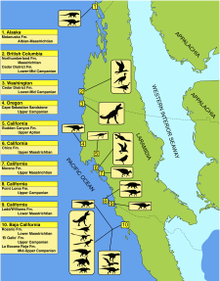Laramidia

Laramidia was a mainland area that occupied the west of the North American continent, which was partly covered by an extensive shallow sea , during the Upper Cretaceous (99.6 - 66 million years ago) . Laramidia was named in 1996 by paleontologist J. David Archibald . It is named after the city of Laramie in the US state of Wyoming , which is located in the corresponding region of today's North America.
geography
Laramidia extended north-south from present-day Alaska down to Mexico at about the level of the state of Michoacán . The expansion in east-west direction, however, was much smaller and only reached from the west coast of today's United States to about the eastern borders of British Columbia or Idaho . From the Turonian to the beginning of the Paleocene , Laramidia was separated from the mainland Appalachia in the east by a shallow shelf sea , the Western Interior Seaway . It was only when this sea slowly retreated in the direction of what is now the Gulf of Mexico that the two mainlands joined to form modern North America.
Paleoecology
The fossil record for Laramidia is considered extremely good and is significantly more informative than that of Appalachia. The land mass in the northern parts offered a subtropical climate with extensive coastal plains and large swamps. In the south, the climate was likely warmer and more tropical than subtropical. The vegetation consisted mainly of flowering seeds , conifers , palm trees and cycads .
Laramidia is best known for its wealth of dinosaur fossils, with the species that occur in the north differing significantly from those further south. The paleontologist Scott Sampson, who has researched the fauna of Laramidia, and other researchers believe that a geographical obstacle separated the north from the south of the land mass and that this led to a divergent evolution of the populations affected. The most common dinosaurs belonged to the group of Hadrosauridae . Another common group were the Ceratopsidae , whose subgroup, the Chasmosaurinae, are considered endemic to Laramidia. Other species living there were members of the Theropoda , Pachycephalosauria and Ankylosauridae groups .
In addition to the dinosaurs, fossil remains of amphibians , fish , pterosaurs and earlier mammals and birds were found. Also invertebrates such as insects and shells were found in the fossil record. A prominent example of a non-dinosaur fossil found is the prehistoric crocodile Deinosuchus , which presumably even hunted dinosaurs.
Individual evidence
- ^ J. David Archibald: Dinosaur Extinction and the End of an Era: What the Fossils Say . Columbia University Press, New York, NY 1996.
- ^ Joshua Slattery, Peter Jürgen Harris: Early Cretaceous to paleocene paleogeography of the Western Interior Seaway: The Interaction of eustasy and tectonism . Ed .: Wyoming Geological Association. 2013, p. 36 .
- ↑ Garland Upchurch Jr., Joan Parrott, Emilio Estrada-Ruiz, Dori L. Contreras: Campanian-Maastrichtian floras on Laramidia: vegetation trends west of the seaway. In: botanyconference.org. June 28, 2017, accessed July 16, 2018 .
- ↑ Peter Miller: Digging Utah's Dinosaurs. In: nationalgeographic.com. May 2014, accessed on July 16, 2016 .
- ^ Scott D. Sampson: New Horned Dinosaurs from Utah Provide Evidence for Intracontinental Dinosaur Endemism. In: plos.org. September 22, 2010, accessed July 16, 2018 .
- ↑ Ashu Khosla, Spencer G. Lucas: Cretaceous Period: Biotic Diversity and Biogeography: Bulletin 71 . Ed .: New Mexico Museum of Natural History and Science. Albuquerque, NM Jan 1, 2016, p. 202-209 .
- ^ Scott D. Sampson: Dinosaur Research. In: scottsampson.net. Retrieved July 16, 2018 .
- ^ Brian Switek: SVP Dispatch: Life on the Lost Continent. In: smithsonianmag.com. November 4, 2011, accessed July 16, 2018 .
